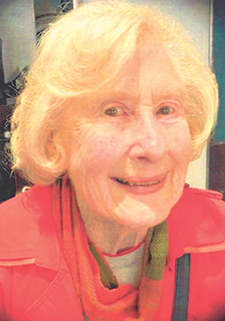Boyne Marie Russell AO
7 October 1931 – 12 February 2022

Boyne Russell was an outstanding physician and one of the first Australian doctors to train in geriatric medicine.
Boyne grew up in the Melbourne suburb of Heidelberg, and graduated in medicine at Melbourne University in 1955 with first class honours; she was third in her year. Following residency in Melbourne, Boyne went to the United Kingdom for specialist training in London and then Cornwall, obtaining Membership of the Royal College of Physicians (MRCP) in Edinburgh.
On her return to Australia with her husband Patrick, Boyne took up an appointment at Mount Royal Hospital in 1972, now known as the Royal Park Campus of Royal Melbourne Hospital. Mount Royal had become a large custodial institution for elderly people, and was the model of care for this population group at the time. At Mount Royal, Boyne was fundamental in establishing the Geriatric Community Care Service in the suburb of Brunswick that was expanded into Coburg in 1976, and subsequently into Essendon, Melbourne and Kew. This became the model for the establishment of geriatric services throughout Victoria and changed the practice of aged care to being community-based. This pilot service was a forerunner of the Aged Care Assessment Services that were rolled out to cover the whole of Australia during the 1980s and early 1990s.
In 1983, Boyne established the first Continence Clinic for older people based at Mount Royal with medical, nursing, and later physiotherapy input. It was soon supported with dedicated inpatient beds. This model eventually led to the establishment of multidisciplinary metropolitan and regional continence services throughout Victoria, a model that later extended to other areas of medical care that are now also formally funded by the State Government. The Continence Clinic also developed a urodynamic service, previously the domain of only a few urology and gynaecology services, initially using equipment that used CO2 as the infusate.
Boyne also established a relationship with the Royal Melbourne Hospital Urology Unit, and in 1991 was appointed as assistant physician to this unit. This added a new dimension to the care of patients with incontinence seen through the unit. This was a rare example, even more than 20 years later, of a physician working with a surgical service. It again demonstrated Boyne as a pioneer and innovator, particularly in an area of medicine that was certainly not 'fashionable'.
Boyne was a great educator, training many of Victoria’s geriatricians from the 1970s to early 1990s. She also involved her trainee aged care registrars in the running of the Continence Service. Training under Boyne’s supervision has had a lasting impact on me and has helped guide me in my medical practice.
Boyne served as the state president of the Australian Geriatrics Society and the Australian Association of Gerontology and Australian Council on the Ageing, and was actively involved with the Continence Foundation of Australia from its inception. She also served on several government advisory committees.
A petite lady with bright red hair and exquisite dress sense, Boyne was a giant intellectually, a formidable adversary who did not suffer fools gladly and was driven in her desire to improve the quality and scope of care for the elderly. Boyne was an astute, compassionate and caring physician and a strong advocate for the rights of individual patients. It was not only her clinical skills that impressed, but the humanistic care that she provided to every single patient. She was a powerful role model and an inspiration for women in a male-dominated profession.
Boyne retired from Mount Royal in 1992, moving to Hobart where she joined the Regional Continence Service at Repatriation Hospital from 1993–1997. She was appointed as an Officer in the Order of Australia in 1994 for her services to medicine and community health, particularly in relation to the care of aged people.
After retirement, Boyne and Patrick led a comfortable life in Hobart, enjoying travel, sailing their boat and entertaining. After Patrick’s death in 2012, Boyne continued to live at home till her death.
Boyne was a pioneer in continence care in Victoria and the development of the medical care of the elderly in Australia. She played an important role in defining geriatricians as physicians specialising in the care of older patients and in moving this from a custodial model to an acute model of care. The services she developed are now commonplace.
I am privileged to have been Boyne’s trainee, colleague and friend.
Dr D Michael Whishaw FRACP
Author(s)
Dr D Michael Whishaw FRACP


